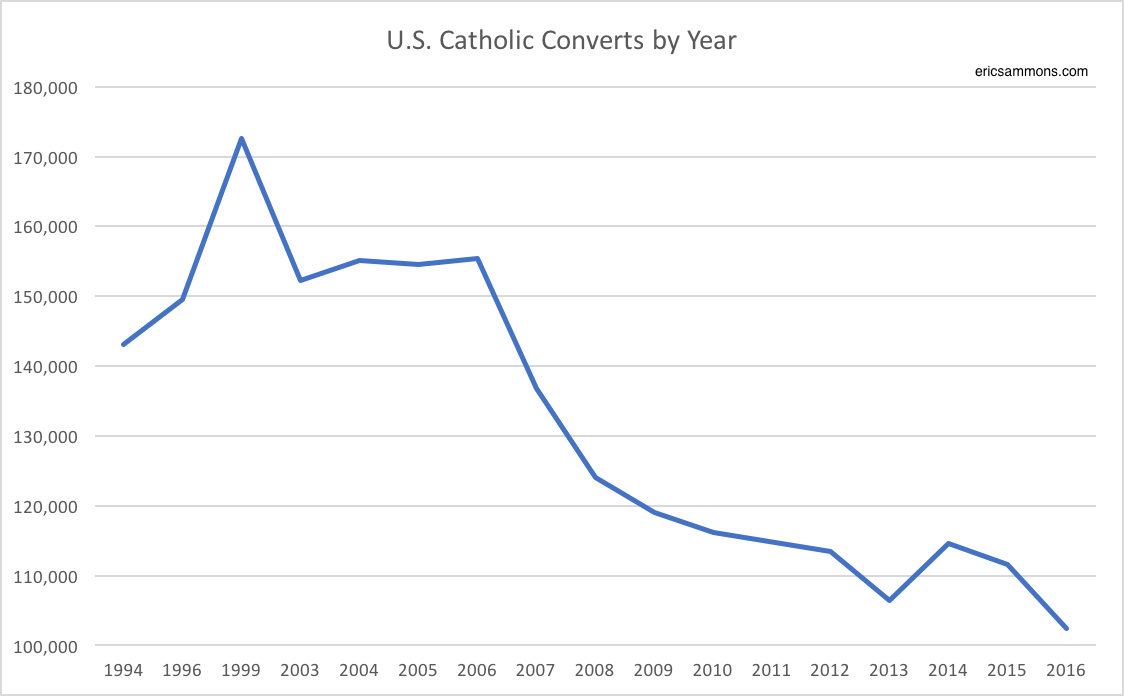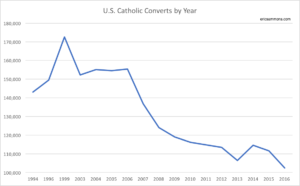Last week the USCCB announced that over 30,000 people would be entering the Catholic Church this Easter. Among Catholics, this news was received with much joy. As someone who entered the Church at Easter twenty-five years ago, I too was rejoicing for the souls that would become full members of the Catholic Church.
But I couldn’t help thinking: is that it? Back in 2005, the USCCB announced that “more than 150,000 Americans will join the Catholic Church on Holy Saturday”. I remember that the 150,000 number was frequently thrown around in those days as the typical number of new Catholics entering the Church each year. So although I’m happy for those 30,000 people who entered this year, I couldn’t help be disappointed as well.
But I still thought 30,000 sounded really low, so I decided to do some digging into the numbers. Using Google and the Wayback Machine I found the USCCB’s Easter convert announcements over the years, dating back to 2004 (when they also said “more than 150,000” people would enter the Church). I thought it would be relatively easy to find the number each year and do a comparison, but what I found was a mess of different statistics, differing methods of reporting, and mistakes from the USCCB. Eventually I was able to wade through to some semblance of reliable numbers. I found that even though the numbers aren’t as bad as a drop from 150,000 to 30,000 in thirteen years, they aren’t encouraging either.
Related: My Facebook Live discussion on these findings
Steady Decline
Almost every Spring since 2004 the USCCB has issued a press release proclaiming the tens of thousands of new members coming into the Church at Easter. But this year was the first time since 2005 they have given an estimated total number. They arrive at that number through some extrapolation, for most dioceses don’t report to them their actual convert numbers. Most years, however, the press release will include the previous year’s Official Catholic Directory total number of adult baptisms and receptions into full communion. The OCD number is the most accurate number to use for how many converts the Church has received each year. Unfortunately, I don’t have access to past Directories, but digging through various sites and press releases, here’s what I found:
| Year | Adult Baptisms | Receptions into Church |
Total |
| 1994 |
66,886 |
76,176 |
143,062 |
| 1999 |
77,578 |
95,003 |
172,581 |
| 2003 |
76,829 |
75,429 |
152,258 |
| 2004 |
73,405 |
81,720 |
155,125 |
| 2005 |
80,817 |
73,684 |
154,501 |
| 2006 |
62,464 |
92,975 |
155,439 |
| 2007 |
49,415 |
87,363 |
136,778 |
| 2008 |
124,000* |
||
| 2009 |
43,279 |
75,724 |
119,003 |
| 2010 |
43,335 |
72,859 |
116,194 |
| 2011 |
unknown |
||
| 2012 |
41,918 |
71,582 |
113,500 |
| 2013 |
39,654 |
66,831 |
106,485 |
| 2014 |
44,544 |
70,117 |
114,661 |
| 2015 |
39,721 |
71,809 |
111,530 |
| 2016 |
38,374 |
64,106 |
102,480 |
*In 2008, I could not find actual OCD numbers, but I did find an article that gave a rounded number from the OCD.
Here are the numbers represented in graph form:
As you can see, 1999 is the modern high point for new Catholics, with over 172,000. The numbers stayed relatively stable in the early 00’s—right around that magical 150,000. But we start to see a decrease in 2007, which essentially continues, with the exception of a tick up in 2014, all the way to 2016, the latest date I have reliable numbers. Most years see about a 5-10% decrease from the previous year. Overall, since 1999 the number of yearly converts has decreased by 40%.
So where does this year’s 30,000 number come from? Have the number of converts really dropped from over 100,000 in 2016 to 30,000 in 2018? I don’t think so. I found that the numbers reported by the USCCB for Easter Vigil aren’t always the total number of converts eventually reported by the Official Catholic Directory at the end of the year. Many people come into the Church at other times of the year, and I also think the USCCB messed up their estimate. If I had to guess, I suspect that the number will most likely around 95,000, based on recent history. A larger number, to be sure, but also a clear decline.
Recognizing the Problem
Everyone has an opinion as to why these numbers are going down. I think it’s a combination of a lot of factors myself, but I’m not interested in the “why” right down. I’m more interested in the attitude of Catholics—particularly Catholic leaders—toward these numbers.
I’ve done Catholic evangelization work for the almost quarter-century at the individual, parish, and diocesan level. One thing I’ve discovered is that the Catholic Church in America is the most self-congratulatory organization I’ve ever seen. You constantly hear bishops praising their “vibrant” dioceses, and priests gushing over their “welcoming” parishes. Lay people love to brag about anecdotal stories of tons of new converts. It’s like the New York Yankees having five straight losing seasons, yet their GM and manager are praising how great they are doing. If you didn’t know the numbers, you could be forgiven if you believed that the Church was growing by leaps and bounds (note: these numbers don’t even reflect the more sobering reality that millions of Catholics—including many of those previous converts—leave the Church each year).
The first step to recovery, they say, is recognizing you have a problem. As long as we delude ourselves into believing we are doing a great job at evangelization, these numbers are going to continue to decline. We need to recognize that how we attract members as a Church is not working, and something needs to change. Only then will we see those numbers reverse their trend and begin to increase each year. Then we will have a real reason to rejoice.
USCCB Easter Convert Announcements:
2004
2005
2006
2007
2008
2009
2010
2011
2012
2013 (none issued)
2014
2015
2016
2017
2018



3 Comments
Not only conversions but Mass attendance, baby baptisms, Catholic school enrollment, vocations, marriages, all dramatically down and still heading that way. There is a book called Index of Leading Catholic Indicators: The Church Since Vatican II by Kevin Jones that describes it all with graphs. I guess I am just not seeing even much of a desire to get those numbers up on the part of our Church leaders.
The voices I’ve heard the most acknowledging the problem of declining numbers seem to be coming mostly from those promoting the Traditional Latin Mass. They claim traditional Catholicism draws people in — to parishes, to religious organizations, and to schools, and that the membership trends of those groups are booming. I don’t actually know the numbers, or if it’s true, but it does make some sense. Perhaps the lack of acknowledgement in general is partially indicative of a desire by many to avoid saying the post-Vatican II Church has been a failure.
I’ve heard the same thing, but I think it’s only anecdotal evidence. I attended a Latin Mass parish for five years, and I wouldn’t say it was “booming.”
Also, the comparisons are often apples to oranges. A traditional order might be attracting a large number of priestly vocations, but it’s drawing from the whole country, whereas a diocese typically only draws from its own geographic region.
This isn’t to disparage traditional groups, and I do believe that any success of traditional groups is downplayed for exactly the reason you mention. But we need to be realistic about the numbers.
Comments are closed.